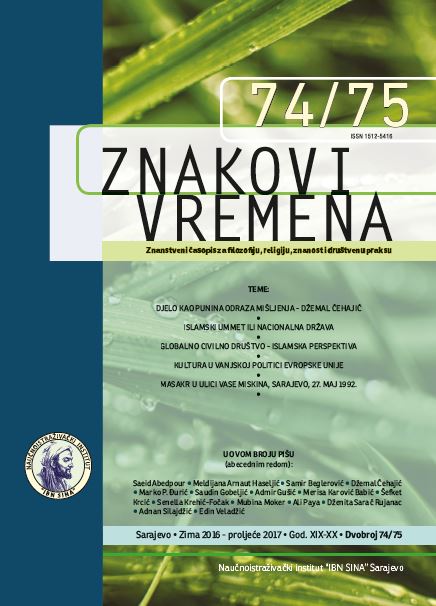Renesansa i mehanizam stagnacije
Renaissance and Mechanism of Stagnancy
Author(s): Shahab Yar KhanSubject(s): Philosophy, Studies of Literature, Comparative Study of Literature, Renaissance Philosophy, 15th Century
Published by: Naučnoistraživački institut »Ibn Sina«
Keywords: Renaissances; stagnancy mechanism; English vernacular and Chaucer; Shakespeare and womanhood; John Dee; witch-burning; secular philosophy; Hossein Nasr; dead philosophy; European philosophy; BBC;
Summary/Abstract: The present article is an attempt to redefine the meaning of Renaissance in Europe as an artful process of seeing life as a manipulable autonomy through the eyes of those who decided to build their ‘selves’ upon the intellectual ruins of human history. All human cultures and societies go through their renaissances but the level of their impact on human mind and its development depends upon the power of ‹the mechanism of stagnancy›. The stagnancy mechanism should be kept in mind while interpreting the meaning of ‘European Renaissance’, since Renaissance did not happen simultaneously throughout Europe and Europe never existed as one integral cultural unit the stagnancy mechanism gave various participant nations different outlook and varying formative outlines. In England for instance, this stagnancy created havoc in 14th century when the issue of vernacular was raised. By the end of the 16th / beginning of 17th century, in a similar way, Shakespeare’s concept of womanhood as opposed to patriarchal system lead to Shakespeare’s early retirement from London’s theatrical life and later his sudden death. The mechanism of stagnancy remained dominant throughout high renaissance and reflected into, perhaps the greatest crime ever committed against humanity - ‘witchburning’. It is also observed in the article if Renaissance is a logically justified term to describe the movement as a Euro-wide phenomenon or does it have different scale of reception and impact for instance, in Italy and the one happening with lesser intensity in, let’s say, Croatia. Theterm ‘Genessance’ (from ‘genesis’, beginning and ‘ssance’ knowledge) introduced as a parallel movement with distinguished features to describe regions which were not part of the classical age of learning is introduced. Genessance was simply ignored by the historians in their desire to see Renaissance as the only way to observe the phenomenon of redefining identity, self and autonomy in their oversimplified understanding of Europe as ‘European life of 15th and 16th century’. Genessance, however, was not the only thing they bypassed. They also ignored that in a vast territory of East and South East Europe another set of intellectual, social, aesthetic structures prospered under the Ottomans until as late as 1860’s. Primussance (Latin, ‘primus’, first and French ‘ssance’). Primussance regions of Europe were well acquainted with the meaning of primordial wisdom and the masses with more confidence and faith in the sciences and various branches of philosophy as it was all reaching them from a long line of spiritual ancestry that they took pride in were leading a lot more balanced social and intellectual life than anywhere else in Western Europe. Regions like Bosnia and Herzegovina were not in need to have any renaissance, they had their own spiritually mature, socially deep rooted academic system and a highly evolved manner of approaching life and nature as coexisting harmony. This region though encountered its own specific kind of mechanism of stagnancy and remained locked within up to the present day.
Journal: Znakovi vremena - Časopis za filozofiju, religiju, znanost i društvenu praksu
- Issue Year: XX/2017
- Issue No: 74-75
- Page Range: 193-213
- Page Count: 21
- Language: English

